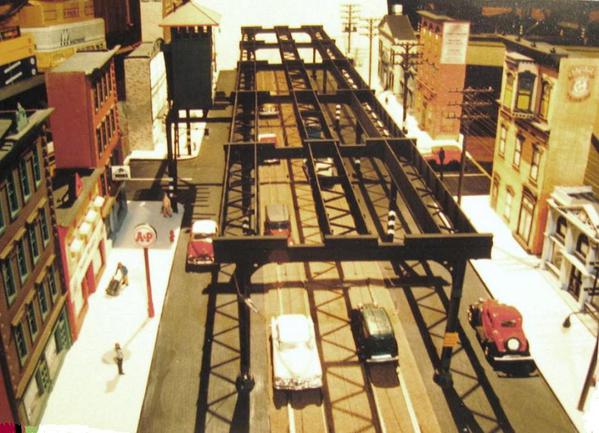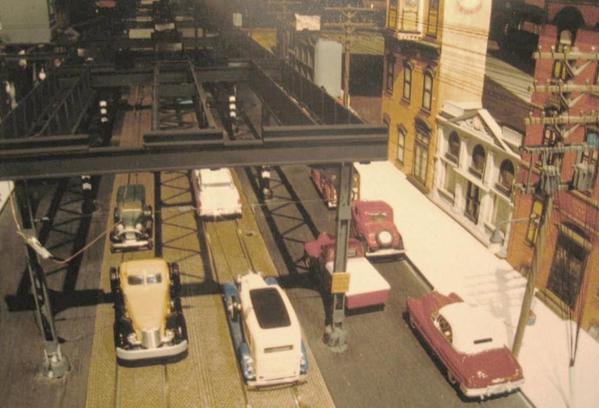Hello Peter (PJB) ---
Sorry for the reply delay - very busy lately -- so I will herein try to answer your questions.
The entire EL Structure and its EL Stations and their structure outrigging are built totally scratchbuilt using various PLASTRUCT structural H and I beam shapes....and also wood segments for most track girders, built up to look like plate girders..
ALSO the EL Station Stairways are all TOTALLY BUILT from scratch, using variously wood, plastic, cardstock, PLASTRUCT girder shapes, etc. The Stations were painted Pullman Green to represent a similar 1940's era green hue used on real NYC EL's. The Station roofs are painted with Oxide Red Primer to replicate the colors on the real roofs.
Here is a complete "construction materials list" that I provided on another OGR "Subways Forum" thread of August 22, 2014 titled "N Y SUBWAY STATION PLATFORM". My list below is quite extensive and long - I suggest you copy, paste and PRINT it on paper for modeling referrence. I suggest you ALSO LOOK UP that thread and my many postings and photos there of the layout and trackwork. Here is the LINK to it:
https://ogrforum.ogaugerr.com/t...way-station-platform
I also make use of various types and thicknesses of cardstock and Evergreen and Plastruct sheet plastic material (even index card stock) for certain structural applications, details, and finishing materials ! Here below is a printed listing I created long ago outlining what I basically used to construct my EL structure "steelwork" and also for creating the EL style track work: EL TRACK started out as ATLAS 2 RAIL Nickel Silver scale Track. Most of the track in my surface ballasted EL Yards is all hand cut ties and hand laid, spiked rails.
======================================================
O SCALE N.Y. City EL Structure and Track Fabrication methods used by Joseph Frank on his O SCALE EL Layout: COMPLETE LISTING BELOW:
========================================================
IF you USE WOOD - use ONLY BASS (strong) and NOT balsa (very soft and spongy) wood for all track or EL structural (ie: Track Girders deck work, etc)
My measurements for bass-wood items can also apply to optional use of Evergreen Styrene shapes also --your choice -- however wood "looks and paints" better! Using Atlas O SCALE 2 rail scale Flex or snap track for track work, I use the following for:
(1) -- TRACK GIRDERS - and CROSS SPAN GIRDERS going from EL Column to Column
________________________________________________________________________
Bass Wood 1/16" x 1" for track girders AND 1/8" x 1" for CROSS (Span) Girders - your choice to use either type for either application.. however I prefer the 1/8" thick units for strength on CROSS SPAN girders. The depth of your girders will be a scale 4 feet and track girders could be made to 12" (48 feet) lengths. To economize you can do 44 feet (11") lengths to get 2 track girders from one 22" long bass wood strip "girder plate" - your choice.
(2) -- Flat "plate girder" strips final Finishing Details
___________________________________________________
These wood plate girders are then faced off on both sides with either "hat" strips or "T" strips 3/32" wide spaced every 1 inch (4 scale feet) along the girder sides to represent plate section joint-seams.
And finally, installing are Top and Bottom web-flanges of track girders --- 3/8" x 1/16" strips -- I prefer styrene strips "ACC'd" to the wood track girder sections tops and bottoms.
(3) -- LONG WOOD CROSSTIES -- 1/8 x 3/16" For O SCALE ATLAS 2 Rail Scale Track.
_________________________________________________________________________
The size can be increased slightly for thicker Gargraves Wood ties (to match end profiles) or for other types of 3-rail track tie thicknesses ---your measurement decision;
These strips come in 22 inch lengths.
(4) -- TRACKSIDE WOOD GUARD TIMBERS -- 5/32" x 5/32"
________________________________________________________
These match height of - or can be a tiny tad lower than) scale 1:48 size Atlas O Scale solid T rail -- YOUR size will (should) reflect the size of the track running rail on the 3-rail track of your choice--and should be a tiny tad below the rail top height to insure clearance of truck sideframe bottoms of ALL trucks of any cars you run on your EL.
NOTE: These in modern times (over the last 15 years) are replaced during major track rebuilding by apprx. 4 real inches prototype wide steel strapping...check nycsubway.org website for photos of trackways in present days for the "look" of these straps. Much of the system still has the wood, however.
(5) -- WOODEN CATWALK PLANKWAYS -- 1/16" x 1/8"
____________________________________________________
This size would remain standard no matter what brand 2 or 3 rail track you use.
(6) -- OUTSIDE 3rd RAIL CHAIR BLOCKS
_____________________________________
These I cut square blocks from 3/16" x 3/16" wood strips of 22' long each.
Can also use Solid STYRENE strips of same size.
(7) -- OUTSIDE "EL STYLE" Uncovered THIRD RAIL
_______________________________________________
I use HO Code 100 rail for 3rd rail with 1:48 2 rail track running rail - or optional code .125 rail if you are using larger than code 148 running rail size on 2 or 3 rail track.
I model pre-1960 IRT and BMT "exposed" early "Elevated style" third rail for joint subway paddle shoes (which slide under a covered third rail "cover board") and "elevated car" drop sled shoes which drop down onto and ride on top of the 3rd rail -- thus not allowing use of a cover board.
(8) -- THIRD RAIL COVER BOARD -- OPTIONAL
______________________________________
This is prototype for todays NYC Transit and LIRR present 3rd Rail System --- you must fabricate the third rail cover using 1/16 x 1/4"
Support "bracket straps" from the ties to the cover board can be made with thin strips of solid brass or steel wire or flat narrow brass strips. A tedious job as you will need (heh) hundreds of these for the cover boards' supports over your third (outside) rails.
(9) -- "EL" SUPPORT COLUMNS -
____________________
I use PLASTRUCT ABS Plastic - Plastruct column size H-10. This is a very strong plastic material.
(10) -- INSIDE OF TRACK GUARD RAILS (between running rails)
_________________________________________________________
Code .148 or slightly lower (smaller) rail --- for my Atlas O Scale 2 Rail Track. The Guard Rails should NEVER be higher (better just a bit lower) than your running rails to clear truck motor bottoms, gears on wheelsets, and those "un-coupler tacks" on MTH subway Car couplers, and etc.
(11) -- CURVED FLANGE-BEARING Guard RAILS
_________________________________________
For my Atlas O Scale 2 Rail Track I use Code .148 rail butted close (rail web to rail web) to the code .148 running rail to form the narrow slot that causes (as in prototype) the back of the wheel flange to slide along the "curved Flange rail" --which guides the inside wheelsets on a curve around the sharp curves and prevents the outer wheel from trying to ride up or over the ouside curved rail. This architectural and engineering design is what
causes the "squeals" on sharp curved EL and subway Tracks...and crews periodically "grease" these flange rails !!
NOTE: ABOVE DETAIL NOT RECOMMENDED for 3 rail operation !
I use pro-scale .135 tread and flange scale steel 30" & 33" insulated 2-rail NWSL wheels on scale profile T-rail Atlas solid rail track, which in this case operate like the real wheels on flanged curve tracks. MTH subway set wheel Treads are too wide and flanges TOO THICK to clear scale-dimensioned (as I have) "curved-flange- rails" slots . This technique is also used on my scale switch tracks ---
BUT ALSO NOT Recommended for 3 rail switches per MTH wheelsets either.
(12) -- CATWALK RAILINGS
___________________________ -
I use PLASTRUCT ABS Plastic Item # HR-8, O Scale Railings
(13) -- ASSORTED SIZES LATTICE STRUCTURAL GIRDERS
__________________________________________________
--for spans, braces, station roof framing and support columns -- get "Central Valley Bridge Girder" kit packages...part 1902-5. Also Check out PLASTRUCT various sized Lattice girder items of same.
I hope this info helps any O Scale Modeler-readers somewhat.
Its ALL the tiny details collectively that make the structure and track work look good!!
Go to my FLICKR ALBUMS Website Photos Website, at:
Also see my PHOTOS ALBUMS PAGE at FLICKR - each album covering various segments of my layout and rolling stock in photos...at:
--save that FLICKR ALBUMS site also --to frequently check track work where there are close-ups of those details!
Regards - Best of Luck !!
Joe F !
Webmaster - NYC Transit Modelers Group Forum Board
====================================================
Peter - continuing, the station lights are very tiny micro-midget bulbs of 1.5 volts DC each, wired in series of 8 bulbs. The EL Column White bands were applied (after very unsuccessfuly painting of same) using 1/4" WHITE auto pinstripe tape, very snugly pressed and fitted around the EL COLUMN I-beams.
Hope the above info help you ! Here are three old photos taken after one particular layout-module's EL structure had repairs made after experiencing some minor damages in transportation via a large 24' long truck to and from a large train show back in 1988 -- sorry for the low quality images, but you see structure without the track.
Regards - Joe F







